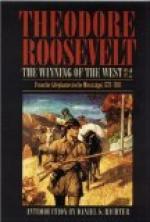In the end the natural result of all this was to involve half the people of Kentucky in lawsuits over their land, as there were often two or three titles to each patch, [Footnote: McAfee MSS.] and the surveys crossed each other in hopeless tangles. Immediately, the system gave a great stimulus to immigration, for it made it easy for any incoming settler to get title to his farm, and it also strongly attracted all land speculators. Many well-to-do merchants or planters of the seaboard sent agents out to buy lands in Kentucky; and these agents either hired the old pioneers, such as Boon and Kenton, to locate and survey the lands, or else purchased their claims from them outright. The advantages of following the latter plan were of course obvious; for the pioneers were sure to have chosen fertile, well-watered spots; and though they asked more than the State, yet, ready money was so scarce, and the depreciation of the currency so great, that even thus the land only cost a few cents an acre. [Footnote: From the Clay MSS. “Virginia, Frederick Co. to wit: This day came William Smith of [illegible] before me John A. Woodcock, a Justice of the peace of same county, who being of full age deposeth and saith that about the first of June 1780, being in Kentuckey and empowered to purchase Land, for Mr. James Ware, he the deponent agreed with a certain Simon Kenton of Kentucky for 1000 Acres of Land about 2 or 3 miles from the big salt spring on Licking, that the sd. Kenton on condition that the sd. Smith would pay him L100 in hand and L100 more when sd. Land was surveyed,... sd. Kenton on his part wou’d have the land surveyed, and a fee Simple made there to.... sd. Land was first rate Land and had a good Spring thereon.... he agreed to warrant and defend the same ... against all persons whatsoever.... sworn too before me this 17th day of Nov. 1789.” Later on, the purchaser, who did not take possession of the land for eight or nine years, feared it would not prove as fertile as Kenton had said, and threatened to sue Kenton; but Kenton evidently had the whip-hand in the controversy, for the land being out in the wilderness, the purchaser did not know its exact location, and when he threatened suit, and asked to be shown it, Kenton “swore that he would not shoe it at all.” Letter of James Ware, Nov. 29, 1789.]
Inrush of Settlers.
Thus it came about that with the fall of 1779 a strong stream of emigration set towards Kentucky, from the backwoods districts of Pennsylvania, Virginia, and North Carolina. In company with the real settlers came many land speculators, and also many families of weak, irresolute, or shiftless people, who soon tired of the ceaseless and grinding frontier strife for life, and drifted back to the place whence they had come. [Footnote: Thus the increase of population is to be measured by the net gain of immigration over emigration, not by immigration alone. It is probably partly neglect of this fact, and partly simple exaggeration,




